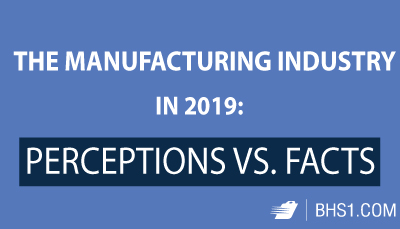We use cookies to make your experience better. To comply with the new e-Privacy directive, we need to ask for your consent to set the cookies. Learn more.
The Manufacturing Industry in 2019: Perceptions vs. Facts

And BHS knows manufacturing; remember, we’re manufacturers, too. Here are a few of the trends we’re watching in the manufacturing industry for 2019:
-
Public perception does not match up with the reality of the manufacturing industry’s successes.
Social currents seem to be creating misleading impressions of U.S. industry, particularly in the manufacturing sector. While media reports and public figures sometimes paint a bleak picture, the numbers speak for themselves.
-
At the close of 2018, many thought the manufacturing industry was in decline. In reality, the opposite was true.
At the end of 2018, the Leading2Lean Manufacturing Index conducted a survey to gauge the public’s perception of the industry. Surprisingly, 70 percent of the respondents thought that manufacturing in the U.S. was declining.
- According to the Manufacturing Index, in fact, the demand for manufacturing jobs suggests that the industry is booming. Over the next 10 years, the Index estimates, manufacturing will create almost 3.5 million job openings, and around 2 million of those will remain unfilled as manufacturers compete over talent.
-
Barring severe economic downturn, manufacturing will continue to be a strong financial driver, and a huge source of employment, for the balance of the year.
Industry research group the MAPI Foundation recently predicted a growth in U.S. manufacturing of 2.8 percent through 2021. That’s nearly twice the prediction the same researchers made in 2017. For 2019, it seems, growth will continue to be a trend.
-
Automation continues its march, but it is a slow one. In the meantime, staffing concerns will keep on limiting growth.
According to analysis from market intelligence provider IDC, only 20 percent of the world’s leading manufacturers will automate large-scale processes by 2021. That means 2019 will face a more immediate concern: There are more jobs in the manufacturing industry than there are workers to fill them.
In one way, at least, manufacturing in 2019 won’t be that different than it is in 2018: Only producers who collaborate heavily with dealers and end-users will avoid the pitfalls of product failure and early obsolescence.
At BHS, we’ve been leaning into this collaborative model for decades now. We don’t build something new and then look desperately for an application to use it. Instead, we talk to our customers, take the time to understand their challenges, and engineer solutions.
Take our custom equipment programs. We can customize any of our products for virtually any use. We’ll even create a brand-new material-handling solution from scratch. All things considered, we’re excited to work with our partners in the manufacturing industry to “provide the highest quality products and best engineered solutions in order to continually improve our customers’ productivity and profitability” in 2019 and beyond.
References:
“Leading2Lean Manufacturing Index.” Leading2Lean. Leading2Lean Lean Execution System, Sept. 2018. PDF. 27 Nov. 2018.
“Top 10 Predictions for Global Manufacturing in 2018: IDC.” IndustryWeek. Informa, 19 Dec. 2017. Web. 27 Nov. 2018.
